1. What is Rajyogi snan (Shahi snan) ?
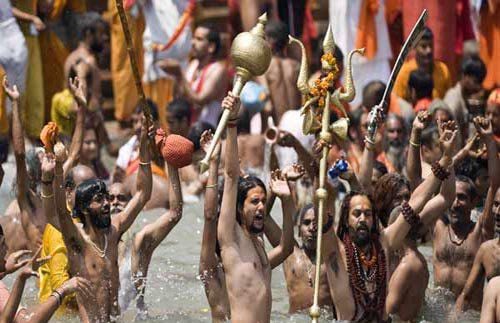
The bathing of Saints and their disciples or Ascetics of the Akhadas on the prescribed days at the beginning of the Kumbh Mela is called a Rajyogi snan (Shahi snan).
2. How does the Rajyogi snan (Shahi snan) happen?
A. The Rajyogi snan (Shahi snan) of the Kumbh Mela begins at 4 a.m.
B. For a Rajyogi snan (Shahi snan), the Ascetics and Saints of the Akhadas take out a weapon-wielding procession which is flanked by huge crowds.
C. The locals decorate the route of the procession with rangolis and petals well in advance.
D. One by one, the Akhadas consisting of their Saints and disciples proceed on the route towards the place of the Rajyogi snan (Shahi snan) with magnificence along with paraphernalia such as elephants, camels, horses etc. amidst playing of music. Some Swamis sit on elephants and some on chariots made of tractor-trolleys. Their disciples hold decorated umbrellas over their heads and the devotees shower flowers on them. Various musical instruments such as dhol, tasha, nagare etc. are sounded and slogans such as ‘Har Har Shankar, Gauri Shankar, Har Har Mahadev |’, and ‘Jai Gangamaiyya ki jai |’ rent the air.
E. Thousands of naked Ascetics with Holy ash smeared on the body wear garlands, hold shining swords or other weapons and flags. When thousands of Naga Ascetics, who look like inhuman figures due to their Holy ash-smeared bodies, loudly hail ‘Har Har Mahadev’, ‘Har Har Gange’, it is almost like watching a live movie.
The royal procession of Sages and Saints taken out on the occasion of the Holy bath is like a procession of Divine attributes such as Tapa (Penance), Dnyan (Knowledge), Vairagya (Renunciation) etc.
3. Why preference is given to
Akhadas for Holy bath in the Kumbh Mela?
In the ancient times, it was inevitable for the Ascetics and Saints in Akhadas to kill while protecting Dharma. Since a bath in the Ganga washes away sins, the weapon-wielding Ascetics and Saints in the Akhadas were given preference for the Rajyogi snan (Shahi snan). The tradition continues even today. The Rajyogi snan (Shahi snan) of the weapon-wielding Ascetics and Saints is considered the biggest ritual in the Kumbh Mela. Until the Ascetics have their Rajyogi snan (Shahi snan), the devotees do not bathe.
4. What happens after the Rajyogi snan (Shahisnan)?
A. After a Holy bath, the procession of Ascetics and Saints have darshan of the temples in the vicinity and return to their place of residence.
B. The devotees stand on both sides of the road, put up arches and flags, and welcome the Ascetics and Saints in a traditional manner for their darshan. The tradition of welcoming the Ascetics and Saints after this Holy bath has been nurtured for many years.
C. Profound devotion of the devotees is visible at the time of the procession. Many women devotees from Kathiawad (in Gujarat) came onto the road despite tight security, touched the dust on the road and applied it to their foreheads.
D. The devotees throng the roads to seek blessings of the Ascetics and Saints when they return to their Akhadas after the Holy bath. Some naked Ascetics stop for some time and bless the devotees, who pay obeisance to them by prostrating, whereas some Ascetics do not allow anyone to come near them. Some Ascetics raise weapons to scare away the devotees. Some Ascetics say, “Do not touch my feet, my penance is still not complete”.
After the Rajyogi snan (Shahi snan), the devotees begin to take a Holy dip in the river.
Reference : Sanatan Sanstha’s Holy Text, ‘Glory of the Kumbha Parva’

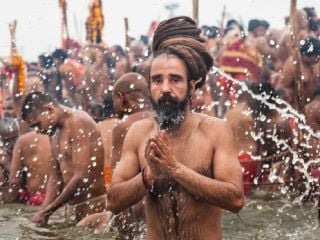
 Holy river
Holy river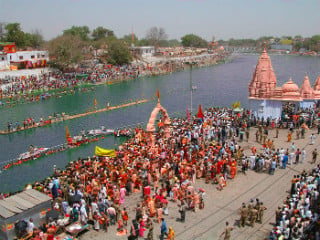 Bathing ghats located along Shipra River
Bathing ghats located along Shipra River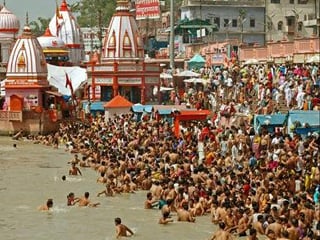 Main Bathing Dates for Kumbha Parva at Haridwar 2021
Main Bathing Dates for Kumbha Parva at Haridwar 2021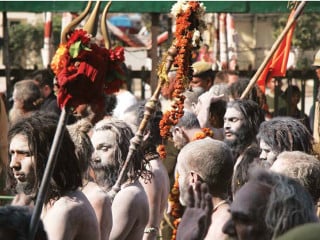 What is Akhada - List of Akhadas
What is Akhada - List of Akhadas